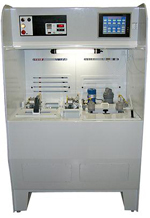 Manual Excellite wafer plating tools
Manual Excellite wafer plating tools
Ideal for a lab setting, the Excellite series of wafer plating tools features a patented plating cell configuration that uses a rotating cathode, along with reciprocating anodes (9000 series) or carousel assembly (8000 series).
During plating, as the wafer rotates around the anode, the center portion of the wafer receives greater exposure to the anodes. The cumulative anode center-line path is traced relative to a wafer when the system is operated at a speed ratio of seven anode cycles per nine rotations of the fixture wheel.
9000 series tools
9000 series tools feature a reciprocating anode assembly that traverses back and forth while the wafer rotates.
Excellite 9001M
The Excellite 9001M wafer plating tool is designed around a unique, patented plating cell configuration that combines planetary and orbital type movements. These movements provide the foundation for plating uniformity.
The Excellite 9001M features one plating vessel designed to plate a single wafer at a time. A high precision pulse DC power supply provides rectification.
Features include:
- Heated dragout rinse
- Quick dump rinse air aspirator
- DI water spray gun
- Nitrogen spray gun.
- Microprocessor-based controls for heat, time, filtration, and fill/dump cycles
- Additional control options in PLC with touch screen, as well as full PC-based control with touch screen, data acquisition, and real-time trending.
- External carboy dump tanks for waste
- Resin-based reclaim systems for precious metal reclaim
Excellite 8000 series
The Excellite 8000 series offers single cell and dual-cell versions. These wafer plating systems are designed around a unique plating tank configuration which combines planetary and orbital type movement, which provide the foundation for plating uniformity.
Excellite 8001—Single cell version
The single cell version features one plating vessel with the capacity of electroplating up to eight wafers at one time. A multi-channel DC power supply allows the operator to adjust the required milliamp current to each individual wafer.
- The electroplating tank features a weir overflow plumbed to a sump tank. The sump tank houses an electric immersion heater and a filtration system.
- Filtered solution is returned to the plating tank through a series of vertical spargers, which circulate the flow towards the face of the wafer.
- A dragout rinse and an overflow rinse tank are included in the base system.
- Options for custom features include quick dump rinses and PLC or computer control.
How it works
Wafers are mounted on individual fixtures, or arm assemblies. Each arm can be removed from the plating tank, or positioned in the tank as plating requirements dictate. The "wheel" to which the wafer is attached rotates as the entire carousel of eight arm assemblies revolves around the carousel. Inert anodes are positioned in different locations around the interior of the carousel, allowing the wafers to "see" the anodes from different angles. This results in a continuously changing distance between the anodes and the wafers. As the wafer moves continuously in relation to the anode, the problem of metal depletion at the face of the wafer is considerably reduced, keeping the deposition rate consistent. This combination of mechanical movements provides the base for superior plating results.
External carboy dump tanks are available for waste, as well as a resin-based reclaim system for precious metal reclaim
Excellite 8002—dual cell version
The dual cell version features two plating vessel, with the capacity of plating up to eight wafers at one time. Multi-channel DC power supplies allow the operator to adjust the required milliamp current to each individual wafer.
The system comes standard with two dragout rinses, a quick dump rinse, and a glove wash. Nitrogen blow-offs and DI spray guns are included.